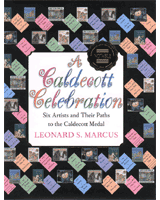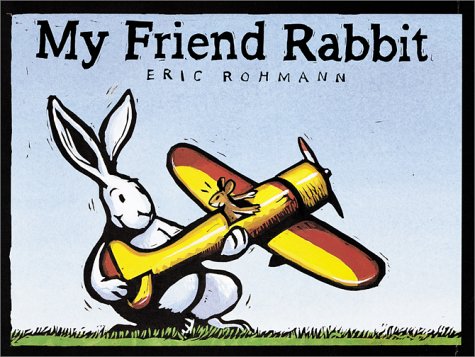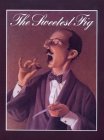 |
|
New picture book published in 2003
Muth, Jon J. 2003. Stone Soup. New York: Scholastic Press. ISBN: 0-439-33909-X.
Jon Muth's retelling of an old classic is a beautifully illustrated adaptation. The story is that of three Chinese monks who happen upon a village while traveling through a mountainous region of China. The village has recently been through hard times, experiencing famine and flooding. The locals are suspicious of outsiders as well as one another. When the monks arrive in the village and the locals scurry home, the monks decide to show the locals how to make "stone soup."
The first villager to approach the monks is a young girl clad in a bright yellow jacket. The otherwise cool colors of the representational watercolor illustrations--blues, grays, and purples--are contrasted by the yellow jacket of the inquisitive young girl. As the author explains in the note that follows the text, "yellow was worn by royalty. And while the little girl in yellow in our story is not an empress, she is someone quite exceptional."
After the little girl joins in the preparations, slowly other curious villagers appear, making contributions while the monks assert that the soup would be better if only they had another ingredient. As the villagers warm up to the monks and one another, the colors in the picture begin to warm up, such as the orange in the carrots, the yellow in the pot and the flames warming the pot. Finally, the villagers get together for a festive meal, complete with good company. As the villagers enjoy their stone soup, the lanterns hanging overhead burn a bright red, a symbol of prosperity and luck in China (BBC 1998).
The message in Muth's story is one in which the characters and thus the readers "learn about--and spread--happiness instead of deception for personal gain" (EdutainingKids.com 2003). Although the dialogue is choppy and unrealistic in some parts, sentences such as "But if only we had mushrooms" give the reader foreshadowing as to what will happen next. Despite that the story's plot becomes predictable, the reader will not finish the story feeling patronized. An invaluable aspect of the book is Muth's note at the end of the book which provides background information on this traditional story and gives details about the illustrations and hidden symbols that comprise the book, "such as the noodles shaped like the Chinese word 'to teach' and the pile of three stones, which form the shape of the sitting Buddha." As though the reader did not already want to flip back through the book to review the illustrations, Muth gives extra incentive with his hidden symbols. For readers of all ages and backgrounds, Muth's Stone Soup is M'm! M'm! Good!
2003. Book Review: Stone Soup. EdutainingKids.com. Available from http://www.edutainingkids.com/reviews/bkstonesoup.html. Accessed 22 January 2004.
|
 |
|
A Caldecott Celebration
Leonard Marcus

Marcus, Leonard. 1999. A Caldecott Celebration: Six Artists Share Their Paths to the Caldecott Medal. New York: Walker & Co. ISBN: 0802786561
A Caldecott Celebration by Leonard Marcus is a review of six Caldecott-winning books, one from each decade spanning the 1940s to the 1990s. This educational and entertaining book gives an historical perspective on one award winning book from each of the featured decades, discussing the creative genius behind the books as well as a more in-depth look at the creative process of the illustrations such as the mediums chosen and the trial and error leading to the books' completion. The Caldecott, which "was named in honor of nineteenth-century English illustrator Randolph Caldecott...is awarded annually by the Association for Library Service to Children, a division of the American Library Association, to the artist of the most distinguished American picture book for children" (ALA). Thus, as reviewer Alex Cary describes, "Art is the major focus here, including photos of each author and their dummies, preliminary sketches, and finished artwork" (Cary).
The photos and illustrations that accompany the stories of each winner are often sketches or "dummies"-preliminary drafts illustrators use to show "what the finished art will look like and how the text will be laid out" (Marcus 1999, 48). While there are a few actual illustrations from the featured books, the author's detailed description of the books and lack of actual illustrations only increases the desire of the reader-be it a child or adult-to seek out each of the titles to see for herself the carefully crafted illustrations that comprise them.
The illustrations selected allow the reader to feel as though they are a part of the process, observing the creation of each of the books. Marcus' carefully chosen quotes draw the reader into the story, pulling them to read further. Maurice Sendak says of his notification that he won the medal, "The moment I heard I had won the Caldecott Medal, I rushed off to the florist and bought heaps of roses, and got into a cab" (Marcus 1999, 19). He goes on to describe the excitement at his publisher's office and the reader can almost imagine being there, sharing his enthusiasm. Alex Cary was right in his assertion that "My only gripe about this lovely little book is that it isn't longer!"
Cary, Alex. Review: A Caldecott Celebration: Six Artists and Their Paths to the Caldecott Medal. Bookpage. Available from http://www.bookpage.com/9901bp/childrens/caldecott_celebration.html. Accessed 21 January 2004.
ALA. Welcome to the Caldecott Medal Home Page! Available from http://www.ala.org/ala/alsc/awardsscholarships/literaryawds/caldecottmedal/caldecottmedal.htm. Accessed 21 January 2004.
|
 |
|

2003 Caldecott award winner
Rohmann, Eric. 2002. My Friend Rabbit. Brookfield: Roaring Brook. ISBN: 0-7613-1535-7.
If it weren't for the pictures, Eric Rohmann's 2003 Caldecott-winning My Friend Rabbit wouldn't be much at all. Rohmann's work is the simple story of a mouse and his friend rabbit who has a tendency to get into trouble no matter what he does.
After getting Mouse's toy airplane stuck in a tree, Rabbit urges Mouse not to worry and devises a plan to get it back down. The pictures tell the story of Rabbit's master plan-stacking a bear on a deer on a rhinoceros on an elephant and so on to reach the plane in the tree. True to Rabbit's nature, the results are disastrous.
Despite the books awards and accolades, the story is dry; the text is nominal. The illustrations however, are brilliant in every sense. Philip Nicholas Pullman describes the illustrations perfectly in his piece on Rohmann--"heavy, chunky, thick black line printed from a relief block. The man was carving this stuff. Not only carving it but hacking into it with force and vigor, leaving little jagged bits uncut, to catch the ink and sparkle blackly on the page; and then painting the result in bright, vibrant colors that blow through the book like a March wind. This wasn't smooth in the least. It shook and quivered and banged and rattled" (2003, 401). In addition, Rohmann's creative use of a dashed line looping through the story help to direct the reader as well as create the frenzied character or Rabbit.
Although the dialogue is unnatural and unrealistic, Rohmann's use of understatement is well balanced by the illustrations, which move the story along. Rohmann explained the logic behind his minimalist text during his Caldecott acceptance speech in stating, "When I was working on the storyboard for My Friend Rabbit, I'd make small sketches inside a rectangle that represented the border of the finished book. Then I'd place that sketch on a larger sheet of paper and draw the action going on outside of the book. When Mouse looks up at the plane stuck in the tree, we don't see the plane, but we understand that he sees the plane. The reader fills those spaces, and the story is told, not only by the person who's made the book but also by the reader. The story is incomplete without the reader, and therefore making a picture book isn't only about what you put in, but also about what you leave out. Making a book is a collaborative act. At some point you have to trust the child reading the book" (2003, 393). You can trust that the bold, vivid, hand-colored relief prints and the sometimes bewildered, sometimes angry expressions of the animals in the story will amuse and engage young readers everywhere.
|
 |
|
Picture Book by
Chris Van Allsburg
Van Allsburg, Chris. 1993. The Sweetest Fig. Boston: Houghton Mifflin Company. ISBN: 0-395-67346-1.
Chris Van Allsburg's ironic tale of a callous dentist is sure to be a literary work appreciated for children for years to come. Monsieur Bibot, a Parisian dentist who despises even his own dog, Marcel is forced to render dental services in exchange for two figs when an elderly patient comes in with no other form of payment. The figs she tells him, however, can make his dreams come true.
Having dismissed the old woman's statement, Bibot eats one of the figs for a snack that night and wakes up the next morning realizing that she was right in fact. He finds himself living the surrealism of his dreams, walking Marcel wearing only his underwear-the quintessential nightmare. Also as in his dream the Eiffel Tower has drooped over.
Bibot devises a plan to make the most of his remaining fig. He hypnotizes himself into dreaming about being the richest man in the world. When he feels that he has sufficiently trained his dreams, Bibot decides it is time to consume the fig. Marcel, the neglected dog, has devised a plan of his own however, and beats Bibot to the punch. The next morning, Bibot awakens to find a role reversal-he is the dog, cowering under the bed, and Marcel is now the master.
As Lauralyn Persson says in her review, "the book is a superb blend of theme, language, and illustration, with a very grabbing plot as well" (1993, 110). The text is easy to follow, yet not condescending. However, it is the artwork that truly makes this book. Van Allsburg's signature realism shines through, giving the reader views from unexpected vantage points, including a dazzling drawing of Bibot and the dog under the bed after the transformation has taken place. Although the tension is high in the story, the sepia and gray tones set a soothing tone. Van Allsburg's representational renderings of Bibot put the character's thoughts right on his face, allowing the reader to gain an understanding of his personality by showing instead of telling. The illustrations in Van Allsburg's book do a wonderful job of helping to tell the story and could be fascinating pieces even outside of the storybook context.

|
 |
|
|



